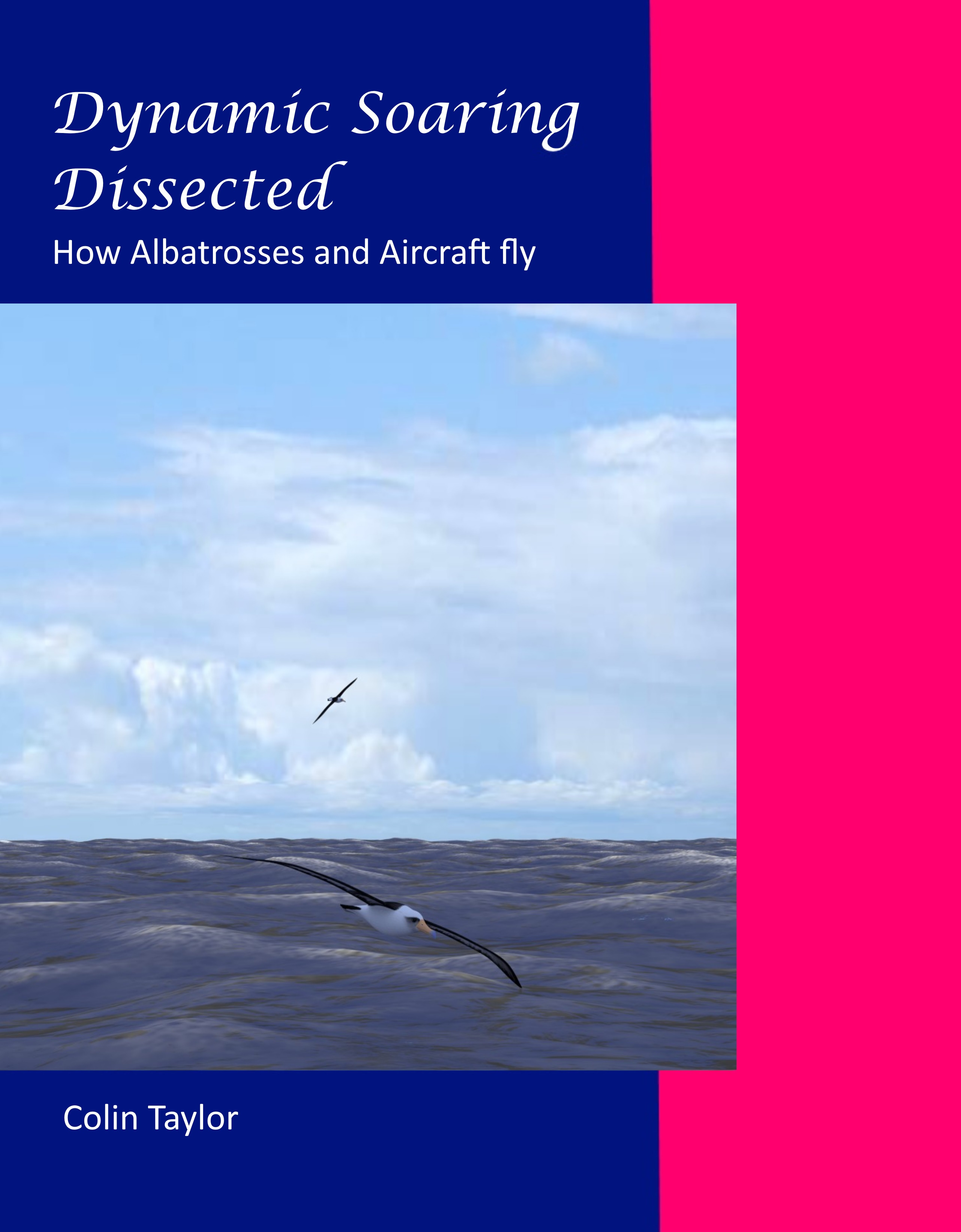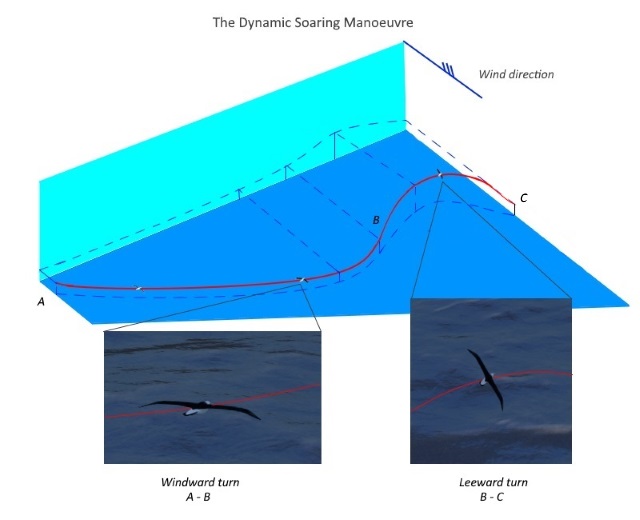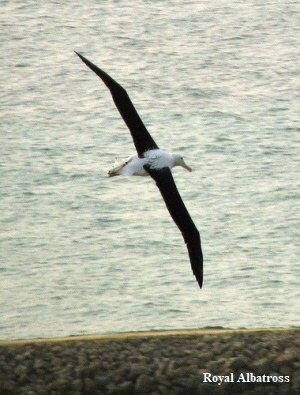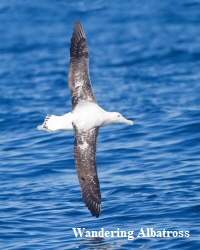Introduction: What does an albatross do all day?
 Since mankind began exploring the great oceans we have been fascinated by the flight of the albatross. These huge birds are seen flying at low level over the sea with a characteristic, apparently effortless, undulating flight pattern mostly without flapping their wings. Research has shown they are capable of flying great distances at high average speeds with very little effort. Their flight manoeuvres are different to those used by land birds on soaring flights, so what are they doing?
Since mankind began exploring the great oceans we have been fascinated by the flight of the albatross. These huge birds are seen flying at low level over the sea with a characteristic, apparently effortless, undulating flight pattern mostly without flapping their wings. Research has shown they are capable of flying great distances at high average speeds with very little effort. Their flight manoeuvres are different to those used by land birds on soaring flights, so what are they doing?
In the ornithology literature, albatross dynamic soaring is normally explained by some variation of the Wind Gradient Theory, which has been repeated without question since Lord Rayleigh’s article in the journal Nature in 1883. Although the wind-gradient does have a role to play in dynamic soaring, it is not the whole story. This website comprises a new description of dynamic soaring, the Windward Turn Theory, which explains how and why the birds fly the way they do. It will explain the true role of the wind gradient but does not depend upon it.
Breaking News!
 Dynamic Soaring Dissected is a new book by Colin Taylor
Dynamic Soaring Dissected is a new book by Colin Taylor
Albatrosses fly over the oceans in swooping, curving flight; gliding thousands of kilometres in search of food, mostly without flapping their wings. This is known as dynamic soaring, which is the use of the energy of the horizontal wind to sustain speed and height. It is different from the soaring flight of most other birds and gliders which use the vertical motion of the air to maintain or gain height. Since the 1880’s, a time before manned gliding flight had been achieved, the mechanism of dynamic soaring has been poorly explained by the Rayleigh cycle or the wind gradient theory. However, there is more to dynamic soaring than the wind gradient and furthermore, the true nature of albatross flight has only recently been revealed by filming and GPS tracking.
Dynamic Soaring Dissected takes up the discussion where it was left in the 19th century and explains how aircraft and birds fly. It looks at albatross flight through the lens of electronic tracking and takes us on a foraging trip with an albatross in long-distance soaring flight. In the Windward Turn Theory, it describes the mechanism of dynamic soaring and the hidden effect of the wind on a bird or an aircraft in flight. It explains the way that albatrosses are able to turn this effect to their advantage and how they are able to dynamic soar crosswind, upwind and downwind. It also describes how radio-control gliders can achieve huge speeds in circling flight and settles the perennial debate on the Myth of the Downwind Turn and what really happens when an aircraft turns downwind and ends up in a stall and spin accident.
Dynamic Soaring Dissected is available through the usual book retailers as a paperback or an Ebook.
The Dynamic Soaring Manoeuvre
When you look at film of albatross in flight, you will see the bird, the ocean and the sky. You will not see the air, nor will you see the birds airspeed, ground speed, drift angle or its acceleration. Everything you can see, the waves, the swell the water and you are moving relative to everything else. The normal view is from the deck of a ship, so that the up and down motion of the bird is very obvious but less obvious is the extent of the left and right turns and their angle to the wind. This is made clearer by GPS tracking of albatrosses which you can see in the Albatross Tracking Data section.

In dynamic soaring, on a scale of kilometers, the albatross flies approximately straight tracks at various angles relative to the prevailing wind; sometimes crosswind sometimes upwind or downwind. On a scale of a few hundred meters, the albatross is continuously turning, climbing and descending. To maintain a constant average heading relative to the wind, the amplitudes of the windward and leeward turns are the same. On an average cross-wind track, the most efficient direction requiring the least amount of effort, the heading is plus and minus about 20 to 30 degrees, turning alternately left and right. The upwind and downwind variants of dynamic soaring require greater effort due to the greater load factor.
Thus, the basic crosswind dynamic soaring manoeuvre comprises a windward turn and a leeward turn. The windward turn is flown with a small angle of bank, at approximately constant height above the surface to take advantage of ground effect and lasting about 5 to 15 seconds. The windward turn starts with a tailwind component, turns across the wind and ends with a headwind component.
The bird then gains height, reverses the direction of turn and flies the leeward turn as a steeply banked wing-over, in which height is gained and lost, starting with a headwind and ending with a tailwind, taking about 2 to 4 seconds before reversing the direction of turn again and commencing the next windward turn. This is shown in the diagram. For an animated version click on this link. Any theory of dynamic soaring has to explain these manoeuvres and aspects of albatross physiology such as their high-aspect ratio wings and their characteristic tube-nostrils.
The upwind and downwind dynamic soaring manoeuvres are explained in separate sections of this website. All versions can be explained by the same basic set of equations but different spreadsheets are used because the shape of the manoeuvre is different in each case. In the rest of this page the crosswind manoeuvre will be described.
The Windward Turn Theory
The Windward turn
In the windward turn, the gliding albatross maintains height above the surface, therefore it loses speed due to the unbalanced horizontal component of the aerodynamic force. Because of the angle of drift, part of this force acts opposite to the direction of the ground-velocity therefore the loss of speed is a loss of ground-speed (and momentum) which is verified by GPS tracking of albatross (and by the everyday experience of manned flight).
The albatross is turning relative to the direction of the wind, therefore it experiences a rate-of-change of the headwind component. Because of this, the airspeed is constant, or even increases slightly, because the tendency to lose airspeed due to the reducing ground-speed is balanced by the tendency to gain airspeed from the increasing headwind component. This effect depends on the rate of change of the head/tailwind component which depends on the birds rate-of-turn. While turning through cross-wind headings, the rate-of-change of the headwind component is at a maximum even though the actual head/tail-wind component is at a minimum. The wind-velocity itself need not change.
The albatross flies the windward turn with the least angle of bank which will give it a rate of turn sufficient to maintain airspeed and height, thereby maximising the distance flown. Flying close to the surface means that ground-effect improves the efficiency of the turn by reducing drag.
 The Leeward turn
The Leeward turn
At the end of the windward turn, the albatross pitches-up and reverses the direction of turn, making the leeward turn as an arched turn or wing-over. A wing-over has a partially ballistic trajectory, with the weight of the bird partly supported by a small vertical component of lift. A wing-over enables the bird to achieve a steep angle of bank to give a large horizontal component of lift without a large increase in actual lift and without a large increase of load-factor and drag. Despite the large bank-angle, the load-factor need only be about 1G and therefore requires minimum effort from the bird.
With a large angle of bank, the horizontal component of lift, added to the drag, creates a horizontal resultant. A large drift-angle then enables a component of this force to act in the same direction of the ground velocity, causing an increase in ground-speed and momentum. The large drift angle is due to the wind being a large proportion of the birds airspeed.
In the leeward turn the headwind component is reducing, therefore the airspeed is constant or reduces slightly. This is because the tendency for the airspeed to increase with the increasing ground-speed is balanced by the tendency to reduce due to the decreasing headwind component.
GPS tracking data clearly shows that there are times when the birds are gaining both ground-speed and height. This gain of energy can only be achieved by aerodynamic forces and not by wind-gradient effects.
The effect of the wind gradient
Climbing upwind and descending downwind through a wind gradient will tend to increase airspeed but only if actual speed is maintained. However, in an upwind climb actual speed must reduce due to gaining height against gravity. In a downwind descent, actual speed will only be maintained by an ever steeper angle of descent as the drag load increases with the increasing airspeed. In other words, the wind-gradient may improve the efficiency of the leeward turn during the climb and descent by reducing the loss of airspeed but not by actually increasing the airspeed. This will be a relatively small effect because the birds fly mainly close to cross wind headings where the head-wind component is at a minimum.
 Conservation of momentum
Conservation of momentum
The motion of the wing through the air deflects the air and imparts momentum to the air. The lift and drag forces are the equal and opposite reactions to the rate-of-change of momentum imparted to the air. When a bird or an aircraft banks in a turn, the lift force tilts with the bird; the vertical component of lift acts opposite to weight; the horizontal component of lift acts as a centripetal force which makes the bird turn. Horizontal momentum is given to the air, opposite to the centripetal direction.
In the windward turn, a component of this horizontal momentum is in the same direction as the wind and gives momentum and energy to the wind. As the albatross loses momentum, so the wind gains momentum.
In the leeward turn, the albatross gains momentum and the wind loses momentum. The birds change of direction is again caused by a centripetal force, a horizontal component of the lift force, the result of the wing imparting horizontal momentum to the air. In the leeward turn, a component of that momentum is opposite to the wind direction, therefore the momentum of the wind is reduced whilst the momentum of the bird is increased.
The bird maintains at least average speed and height during successive windward and leeward turns. For one unit mass of bird, the change of momentum is about the same in each turn. However, as the bird flies, it encounters successive different unit masses of air. The leeward turn is shorter than the windward turn and fewer unit masses of air are accelerated; compared with the windward turn which is longer and in which a greater number of unit masses of air are given less acceleration. So, per unit mass of air, the wind loses more speed in the leeward turn than it gets back in the windward turn. The difference in energy (proportional to speed squared) is equivalent to the birds drag energy losses. In effect, wind-speed has been converted into air turbulence in the wake of the bird. Ultimately that turbulence energy is converted to heat energy at the molecular level and dissipated throughout the air.
In this way, the albatrosses bias the exchange of energy in their favour and, provided they gain slightly more airspeed and height in the windward turn than they lose in the leeward turn, then they can continue soaring indefinitely as long as the wind blows.
 The Nature of the Wind
The Nature of the Wind
The wind is not the same as a box of air moving with uniform velocity. The wind simply has a particular velocity at a particular place and time when encountered by the albatross. When the albatross passes, the air becomes accelerated and the wind-velocity at that point increases or decreases a little bit. Overall, the wind loses some speed but the energy returns to the air in the form of turbulence in the wake of the bird.
In this explanation of dynamic soaring, the wind is considered to be uniform in the sense that it has no intrinsic acceleration and there is no wind-gradient. However, the wind becomes accelerated during the passage of the bird.
Wind-velocity is caused by temperature and pressure variations within the atmosphere and wind energy is derived from the energy of the sun. The wind moves along a curved path over the surface of the Earth and is measured relative to the surface of the Earth. Momentum in the wind is gained by acceleration of the air, not by acceleration of the ground. For the purposes of explaining dynamic soaring, the ground can be thought of as stationary and an approximate inertial frame of reference.
What else is in this website?
The Windward Turn Theory described in this new revision is an explanation of dynamic soaring as practised by the albatross and other oceanic birds. To understand it you only need an open mind but high school maths will help. This page is a brief introduction to the theory.
The next page, Windward Turn Theory is a more detailed, verbal explanation of what you have read on this page.
The Analysis page has the scary maths.
There is a critique of Lord Rayleigh’s article on The Soaring of Birds in Nature but if you are familiar with the classic wind-gradient theory you might like to check out the Wind Gradient Theory page first - to purge your mind.
The Albatross Tracking Data page has an analysis of some GPS tracking data which helps to illustrate the variation of air and ground velocities during albatross dynamic soaring.
The Laysan Albatross Tracking Data page is a new section which contains an analysis of 46 hours of GPS data. It shows how dynamic soaring is used by a real albatross during a foraging expedition North of the Hawaiian islands.
It should be noted that that dynamic soaring as practised by albatrosses is not exactly the same as the dynamic soaring done by RC model glider pilots. That is described in the RC gliders Lee Soaring section. However, there is a connection here. Albatrosses appear to use a variation of the lee-soaring technique which does require a wind-gradient, when they want to soar upwind and that is described on the Upwind dynamic soaring page. In fact we seem to have come full-circle in that I can finally explain the true role of the wind-gradient in Dynamic Soaring.
There is a page discussing the Downwind Turn Myth and this contains a more generalised account of the effect of the wind on an aircraft during turning flight.
Avian respiration is a new addition. This is an attempt to de-bunk another myth of ornithology that the lungs of birds have a one-way flow of air through them
Dynamic soaring on YouTube
Search on YouTube for ‘albatross dynamic soaring’ and you will find several films on this subject
For a 15 minute animated version of this website click Dynamic Soaring The Flight of the Albatross
For a 15 second animated visualisation of the dynamic soaring manoeuvre For an animated version click on this link.
An animated illustration of avian respiration can be found at avian respiration
Dynamic soaring for birds
This website was first published in 2012 and is a work in progress, subject to amendments as new information is gleaned..
CGT 2023
